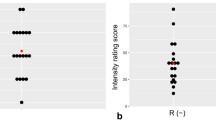Abstract
Male rats were tested in a simple olfactory habituation and discrimination paradigm. Untreated rats habituated their responses over three trials to one odour but were capable of recognising a novel odour presented on the fourth trial. Administration (SC) of either scopolamine or N-methylscopolamine before trials commenced produced a decrease in overall responding. Scopolamine, but not N-methylscopolamine, also blocked habituation to the first odour and recognition to the second, novel odour. Administration of scopolamine after trial 3 did not block the ability of the animals to respond differentially to a novel odour, although again overall levels of responding were decreased. Electrolytic lesions of the medial septal area increased overall levels of responding but lesioned animals still habituated their response over trials and were capable of recognising a novel odour. Therefore although cholinergic mechanisms appear to be involved in this type of learning, these effects are unlikely to be mediated via the septohippocampal system.
Similar content being viewed by others
References
Carlton P (1963) Cholinergic mechanisms in the control of behaviour by the brain. Psychol Rev 70:19–39
Caulfield MP, Clover KF, Powers DA, Savage T (1983) A rapid and convenient method for the implantation of cerebroventricular cannulae in rats. J Pharmacol Methods 9:231–236
Cheal M (1981) Scopolamine disrupts maintenance of attention rather than memory processes. Behav Neural Biol 33:163–187
Cheal M, Klestzick J, Domesick VB (1982) Attention and Habituation: odour preferences long term memory and multiple sensory cues of novel stimuli. J Comp Physiol Psychol 96 (1):47–60
Corwin J, Serby M, Conrad P, Rotrosen J (1985) Olfactory recognition deficit in Alzheimer's and Parkinsonian dementias. IRCS Med Sci 13:260
Doty RL, Reyes PF, Gregor T (1987) Presence of both odour identification and detection deficits in Alzheimer's disease. Brain Res Bull 18:597–600
Dunnett SB (1985) Comparative effects of cholinergic drugs and lesions of nucleus basalis or fimbria-fornix on delayed matching in rats. Psychopharmacology 87:357–363
Eichenbaum H, Shedlack KJ, Eckman KW (1980) Thalamocortical mechanism in odour-guided behaviour. Brain Behav Evol 17:255–275
Eichenbaum H, Fagan A, Cohen NJ (1986) Normal olfactory discrimination learning set and facilitation of reversal learning after medial-temporal damage in rats: implications for an account of preserved learning abilities in amnesia. J Neurosci 6:1876–1884
Elsberg CA (1935) The sense of smell VIII. Olfactory fatigue. Bull Neurol Inst New York 4:479–495
Fonnum F (1975) A rapid radiochemical method for the determination of choline acetyl transferase. J Neurochem 24:407–409
Ghonheim MM, Mewaldt SP (1975) Effects of diazepam and scopolamine on storage, retrieval and organisational processes in memory. Psychopharmacologia 44:257–262
Hagan JJ, Jansen JHM, Broekkamp CLE (1987) Blockade of spatial learning by M1 muscarinic antagonist pirenzepine. Psychopharmacology 93:470–476
Helper D, Olton D, Wenk G, Coyle J (1985) Lesions of the nucleus basalis magnocellularis and medial septal area of the rat produce qualitiatively similar memory impairments. J Neurosci 5:866–873
Hunter AJ, Roberts F, Tutty CA (1986) Scopolamine impairs performance on the Morris Water Maze in both naive and trained rats. Br J Pharmacol 87:41
Miyamoto M, Kato J, Narumi S, Nagaoka A (1987) Characteristics of memory impairment following lesioning of the basal forebrain and medial septal nucleus in rats. Brain Res 419:19–31
Negus V (1958) A comparative anatomy of the nose and paranasal sinuses. Livingstone Edinburgh
Overton DA (1966) State-dependent learning produced by depressant and atropine-like drugs. Psychopharmacologia 10:6–31
Perry EK, Tomlinson BE, Blessed G, Bergmann K, Gibson PH, Perry RH (1978) Correlation of cholinergic abnormalities with senile plaques and mental test scores in senile dementia. Br Med J 2:1457–1459
Reiff M (1956) Untersuchungen über natürliche und synthetische Geruchstoffe, die bei Ratten und Mäusen eine stimulierende Wirkung auslösen. Acta Trop 14:289–318
Rotter A, Field PM, Raisman G (1979) Muscarinic receptors in the cental nervous system of the rat III Postnatal development of binding of [3H]propylbenzilylcholine mustard in the midbrain and hindbrain. Brain Res Rev 1:185–205
Slotnick BM (1985) Oltactory discrimination in rats with anterior amygdala lesions. Behav Neurosci 99:956–963
Slotnick BM, Katz HM (1974) Olfactory learning-set formation in rats. Science 185:796–798
Soffie M, Lamberty Y (1988) Scopolamine effects on juvenile conspecific recognition in rats: possible interaction with olfactory sensitivity. Behav Process 17:181–190
Staubli U, Ivy G, Lynch G (1984) Hippocampal denervation causes rapid forgetting of olfactory information in rats. Proc Natl Acad Sci USA 81:5885–5887
Staubli U, Baudry M, Lynch G (1985) Olfactory discrimination learning is blocked by leupeptin, a thiol protease inhibitor. Brain Res 337:333–336
Steinbrecher W (1962) Die Duftwahl von Wander- und Hausratten. Z Angew Zool 49:301–349
Stevens R (1981) Scopolamine impairs spatial maze performance in rats. Physiol Behav 27:385–386
Warburton DM (1987) Drugs and the processing of information. In: Stahl SM, Iversen SD, Goodwin EC (eds) Cognitive neurochemistry Oxford University Press, Oxford, pp 111–134
Wilcock GK, Esiri MM, Bowen DM, Smith CCT (1982) Correlation of cortical choline acetyltransferase activity with the severity of dementia and histological abnormalities. J Neurol Sci 57:407–417
Author information
Authors and Affiliations
Rights and permissions
About this article
Cite this article
Hunter, A.J., Murray, T.K. Cholinergic mechanisms in a simple test of olfactory learning in the rat. Psychopharmacology 99, 270–275 (1989). https://doi.org/10.1007/BF00442821
Received:
Accepted:
Issue Date:
DOI: https://doi.org/10.1007/BF00442821




